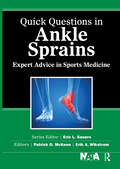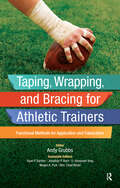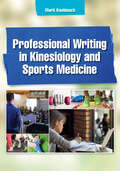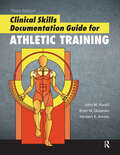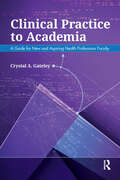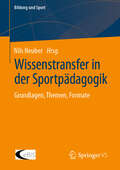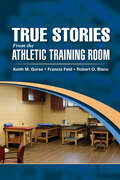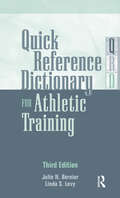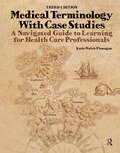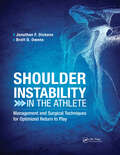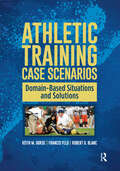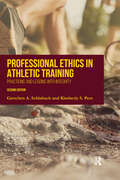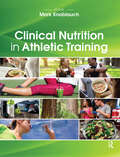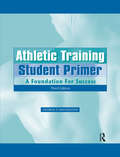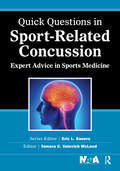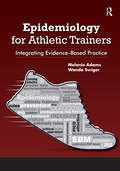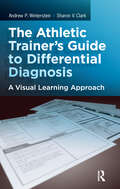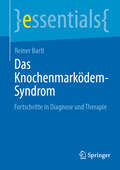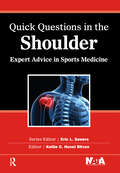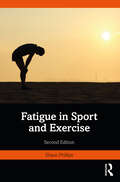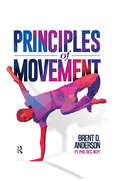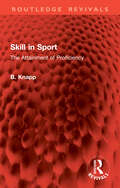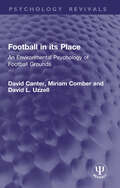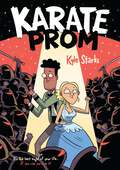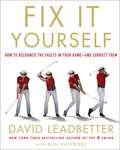- Table View
- List View
Quick Questions in Ankle Sprains: Expert Advice in Sports Medicine (Quick Questions in Sports Medicine)
by Patrick McKeon Erik WikstromAre you looking for concise, practical answers to questions that are often left unanswered by traditional sports medicine references? Are you seeking brief, up-to-date, expert advice for common issues that can be encountered when working with athletes?Quick Questions in Ankle Sprains: Expert Advice in Sports Medicine provides a unique format of concise and to the point responses with clinical application, backed by the latest research on sports-related ankle sprains among athletes. Drs. Patrick O. McKeon and Erik A. Wikstrom and their contributors present 39 common clinical questions regarding the prevention, assessment, treatment, management, and rehabilitation of ankle sprains. Co-published with the National Athletic Trainers’ Association, Quick Questions in Ankle Sprains: Expert Advice in Sports Medicine provides concise answers to 39 frequently asked clinical questions. Written in a conversational tone, the authors of the individual questions represent a variety of different backgrounds and are experts in their respective field. The variety of questions and brevity of responses will make this a book that is easy to read and reference at the point of care.Some sample sections and questions include: Risk and reduction of ankle sprainsWhat effect does prophylactic bracing and/or taping have on reducing lateral ankle sprain risk? DiagnosisWhat are the most useful clinical tests to accurately diagnose syndesmotic and medial ankle sprains? Treatment and rehabilitationTo what extent should I use manual therapies to treat ankle sprains and chronic ankle instability? Surgical considerationsWhen should I refer my patient with an ankle problem to an orthopedic surgeon? Quick Questions in Ankle Sprains: Expert Advice in Sports Medicine is the perfect at-your-side resource for the athletic trainer, team physician, or sports medicine clinician looking for practical answers to sports-related ankle sprain questions. The concise and conversational tone allows the reader to readily apply the information into their everyday practice.Other books in the Series Include: Quick Questions in Heat-Related Illness and Hydration Quick Questions in Sports-Related Concussion Quick Questions in the Shoulder
Taping, Wrapping, and Bracing for Athletic Trainers: Functional Methods for Application and Fabrication
by Andy GrubbsFor many years, sports medicine and health care practitioners have used taping and bracing for both the prevention and rehabilitation of injuries; consequently, specific protocols and techniques have evolved to ensure that the results are functional. With numerous methods available for orthopedic injuries, many texts go into all the applications in a given area or injury and leave readers wondering which one works best or is more useful. Taping, Wrapping, and Bracing for Athletic Trainers: Functional Methods for Application and Fabrication is a collection of some of the most commonly used and most functional taping, wrapping, and bracing techniques for orthopedic injuries.Andy Grubbs has designed this text to not only show the best method(s) for a given area but to add another method to each clinician’s bag of tricks. Taping, Wrapping, and Bracing for Athletic Trainers focuses on the most functional and useful methods in clinical settings and each application is performed in the proper manner to ensure functionality. With the step-by-step instructions, athletic trainers, coaches, and allied health care practitioners will gain comprehensive knowledge and practical skills to understand, reproduce and master the useful taping techniques. While this book offers material recommendations for each technique, it is important to understand that some taping techniques can be performed with a number of different types of taping materials.Features: Includes over 300 images Videos accompany each technique to further capture application and assist in technique mastery Covers basic anatomy and common injuries for each body region, as well as casting and splint making techniques Offers material recommendations for each bracing and taping technique Included with the text are online supplemental materials for faculty use in the classroom.Taping, Wrapping, and Bracing for Athletic Trainers: Functional Methods for Application and Fabrication will enhance any athletic training student or clinician’s current techniques along with providing recommended applications for taping and bracing for both prevention and rehabilitation of injuries.
Professional Writing in Kinesiology and Sports Medicine
by Mark KnoblauchPublication of a research article can be a defining moment in a researcher’s career. However, the steps involved in turning an initial research question into a published article can be a long and arduous journey. To aid in this process, Professional Writing in Kinesiology and Sports Medicine was developed to serve as a comprehensive writing guide for research professionals and students who are looking to improve their academic writing skills. Dr. Mark Knoblauch and his 15 contributors developed Professional Writing in Kinesiology and Sports Medicine to focus around the area of manuscript development and presentation, while also including chapters that outline the foundational concepts of professional writing, developing a research grant, and the journal selection process. Each chapter is written by content experts who bring a wealth of experience not only from their own academic writing but also from having spent countless hours helping students become better, more effective writers. Many textbooks have been written that focus on development of the research manuscript itself, but what sets Professional Writing in Kinesiology and Sports Medicine apart is that it includes so much more to aid writers in their process.What you can find inside: Examination of ancillary aspects associated with academic research such as poster and oral presentations How to choose the most effective journal How to deal with the stress of writing How to write an effective grant Professional Writing in Kinesiology and Sports Medicine covers those topics and more, with the intent of providing a thorough, practical writing guide that spans the breadth of the research manuscript development, writing, and presentation process. Throughout the textbook, sample writings and cases relevant to the fields of kinesiology and sports medicine are used to provide the reader relevant, applicable examples to help improve their own writing.
Clinical Skills Documentation Guide for Athletic Training
by John Hauth Brian Gloyeske Herb AmatoFor more than 15 years, Clinical Skills Documentation Guide for Athletic Training has been an invaluable resource for athletic training students to learn, practice, and master clinical skill sets throughout their educational career. A textbook that can be used from the start of their education up until graduation becomes essential to this learning process.Clinical Skills Documentation Guide for Athletic Training, Third Edition includes a more user-friendly layout for the student. Organized by the Athletic Training Education Competencies, Fifth Edition and the associated content areas, this Third Edition allows for easier integration into the classroom, laboratory activities, and clinical assessment.The organization of skills around Athletic Training Education Competencies, Fifth Edition, including crosswalk information from the latest BOC Role Delineation Study/Practice Analysis, Sixth Edition, aligns the skill sheets from Clinical Skills Documentation Guide for Athletic Training, Third Edition with commonly used texts and reference materials.What is in the Third Edition: A user-friendly layout organized by the Athletic Training Education Competencies, Fifth Edition and mapped by the BOC domains New clinical skill assessment forms in the areas of acute care, prevention and health promotion, and therapeutic interventions Includes references to specificity, sensitivity, and evidence-based practice guidelines where appropriate The Program Assessment chapter provides faculty with an excellent resource for tracking mastery of skills and program outcome achievement Instructor’s materials consist of online versions of the clinical integration proficiencies Included with the text are online supplemental materials for faculty use in the classroom.With an updated user-friendly layout and new clinical skill assessment forms, the Third Edition of Clinical Skills Documentation Guide for Athletic Training will be invaluable for students, faculty, clinical preceptors, and practicing athletic trainers who want to learn or enhance understanding and mastery of essential clinical skills.
Clinical Practice to Academia: A Guide for New and Aspiring Health Professions Faculty
by Crystal GateleyDesigned to assist health professionals with the transition from a clinical role to a faculty role, Clinical Practice to Academia: A Guide for New and Aspiring Health Professions Faculty provides a comprehensive overview of higher education for new and aspiring faculty across health professions including occupational therapy, physical therapy, athletic training, nursing, speech-language pathology, clinical and diagnostic sciences, and pharmacy. This practical guide explores the complexities of the faculty role and includes specific strategies related to teaching and learning in the health professions. Written by Dr. Crystal A. Gateley, Clinical Practice to Academia includes an overview of the issues most impacting academics today. Chapters are placed within the context of current health care and higher education settings. Conceptual foundations of teaching and learning are reviewed, and specific strategies for classroom instruction are provided. The text also includes suggestions for ongoing professional development through the first few years and beyond. Unique aspects of Clinical Practice to Academia include: Introduction to institutional differences that affect faculty roles Focus on the first few years of an academic career Recommendations for exploring campus and professional resources Overview of today’s college students Self-directed learning activities in each chapter for further exploration of topics With practical advice that can be tailored to unique faculty roles, Clinical Practice to Academia: A Guide for New and Aspiring Health Professions Faculty is a must-have for any health care professionals who are moving into academia.
Wissenstransfer in der Sportpädagogik: Grundlagen, Themen, Formate (Bildung und Sport #34)
by Nils NeuberForschung und Lehre gelten gemeinhin als die zentralen Aufgaben von Universitäten. In den letzten Jahren kommt als „Third Mission“ der Transfer akademischen Wissens in die Praxis hinzu. Dafür mangelt es jedoch oft noch an Konzepten und Formaten. Das gilt auch für die Sportwissenschaft im Allgemeinen und die Sportpädagogik im Besonderen. Vor diesem Hintergrund werden mit dem Band Grundlagen, Themen und Formate sportpädagogischer Transferaktivitäten zusammengetragen und systematisiert.
True Stories From the Athletic Training Room
by Francis Feld Keith Gorse Robert BlancAre you a student who has made the exciting decision to become an athletic trainer? Are you a faculty member looking to share with your students lessons, tips, and examples of what they can expect from this challenging and rewarding profession? Are you a new clinician just beginning your career and looking ahead to many fulfilling years of working with athletes? Then True Stories from the Athletic Training Room is the perfect text for you.True Stories from the Athletic Training Room is a collection of 35 true-to life stories shared by certified athletic trainers from their work in industrial settings, high schools, colleges, professional teams, and sports medicine clinics. Brought together by Keith M. Gorse, Francis Feld and Robert O. Blanc, True Stories from the Athletic Training Room is organized by the five domains of athletic training: Injury and Illness Prevention and Wellness Protection Clinical Evaluation and Diagnosis Immediate and Emergency Care Treatment and Rehabilitation Organizational and Professional Health and Well-being With this user-friendly organization, readers will be able to easily find examples of any true story they could imagine. Each story features the actual occurrence as it was told by the certified athletic trainer and gives the readers an opportunity to get a genuine feel of what the athletic training profession is really all about, with just a turn of the page.True Stories from the Athletic Training Room will provide athletic training students, faculty, and clinicians the closest thing to a crash-course by exposing them to a diverse array of true to life occurrences about the past and present of health care management in sports and active lifestyles.
Quick Reference Dictionary for Athletic Training
by Linda Levy Julie N. BernierFor more than 10 years, the Quick Reference Dictionary for Athletic Training has assisted clinicians and students in applying current concepts applicable to the profession while in the classroom, clinic, or on the field.Now updated into a Third Edition, this pocket-sized, comprehensive, and user-friendly companion guide is an essential resource from Dr. Julie N. Bernier and Dr. Linda S. Levy.With over 2100 terms and 20 appendices, the Quick Reference Dictionary for Athletic Training, Third Edition includes a more complete series of neurologic and musculoskeletal special tests, as well as available evidence-based data including likelihood ratios, and interrater and intrarater reliability data to support the use of each test.Additional updates include:• References to accreditation• Goniometric range of motion measures• Pharmacology• Concussion assessment protocol• The NATA’s Code of EthicsThe Quick Reference Dictionary for Athletic Training, Third Edition will textually and visually provide the athletic training clinician and student with a quick overview of the essential elements of the profession.
Medical Terminology with Case Studies: A Navigated Guide to Learning for Health Care Professionals
by Katie Walsh FlanaganMedical Terminology With Case Studies: A Navigated Guide to Learning for Health Care Professionals, Third Edition, is a fun, engaging, and easy-to-read resource on medical terminology for allied health students in athletic training, occupational therapy, physical therapy, and more.Featuring such memorable characters as Skully, the pirate skeleton, and Tango, his trusty parrot, Medical Terminology With Case Studies contains colorful illustrations throughout the text along with tear-out worksheets for students at the end of each chapter. The book is appropriate for students in both college and high school settings.The textbook is divided into three sections, each one covering key concepts and ideas related to medical terminology: Section I: A general overview of medical terminology, delving into its uses, purposes, and career-specific applications across specialties Section II: An in-depth examination of the specific body systems (musculoskeletal, cardiovascular, respiratory, neurological, gastrointestinal, integumentary, endocrine, urinary, reproductive, and sensory) and the associated prefixes, suffixes, and combining forms that go along with them Section III: Appendices, including medical abbreviations, ICD/CPT medical coding, and pharmacology terms Updated features in the Third Edition include: New terms throughout Updated graphics throughout New case studies New chapter on health professions Updated chapter bibliographies Included with the text are online supplemental materials for faculty use in the classroom.Combining bright, colorful characters with easy-to-read resources, Medical Terminology With Case Studies: A Navigated Guide toLearning for Health Care Professionals, Third Edition, is an invaluable terminology guide for allied health students.
Shoulder Instability in the Athlete: Management and Surgical Techniques for Optimized Return to Play
by Jonathan Dickens Brett OwensShoulder Instability in the Athlete: Management and Surgical Techniques for Optimized Return to Play is a groundbreaking text that covers all aspects of care for athletes with shoulder instability—from on-the-field management and treatment to successful return to play. Edited by Drs. Jonathan F. Dickens and Brett D. Owens and featuring the expertise of internationally recognized surgeons who specialize in shoulder instability in high-level athletes, Shoulder Instability in the Athlete is a unique collaboration applicable across a variety of professional areas. This will be the premiere reference for physicians, surgeons, therapists, trainers, and students involved in the care of athletes. Each chapter of Shoulder Instability in the Athlete reviews cutting-edge clinical and surgical techniques, as well as outcomes and return to play criteria. In-depth analysis of appropriate literature and outcomes specific to the athlete population are also presented. Important sections within the text include: Principles for the team physician Anterior instability Posterior instability Special topics in instability By focusing specifically on the unique and challenging dilemma of caring for the athlete with shoulder instability, Shoulder Instability in the Athlete will be a valuable reference for all health professionals who manage athletes.
Athletic Training Case Scenarios: Domain-Based Situations and Solutions
by Francis Feld Keith Gorse Robert BlancEvery case that athletic trainers respond to is unique, but by exposing themselves to a variety of scenarios, they can be prepared for almost any situation. Case studies are the easiest way to find this information, but oftentimes, they come in the form of informal anecdotes or only relate to very specific subjects. Athletic Training Case Scenarios: Domain-Based Situations and Solutions is designed to fill this gap by providing a large number of studies from all five of the domains of athletic training. Keith M. Gorse, Francis Feld, and Robert O. Blanc have gathered true-to-life scenarios for each of the five domains of athletic training, resulting in expert advice on the best response to many possible scenarios. These scenarios were shared by the certified athletic trainers who originally responded to them coming from their work in industrial settings, high schools, colleges, professional teams, and sports medicine clinics. Each scenario features the actual case as it was first assessed by the athletic trainer in order to give readers an opportunity to use their own judgment and decide the best course of action before the original athletic trainer’s own response and recommendations are given. Organized by domain, readers will be able to easily find examples of any case they could imagine. Each domain (prevention, evaluation and diagnosis, emergency care, treatment and rehabilitation, and organizational and professional health) has over a dozen scenarios designed to encourage critical thinking. This format gives readers the closest thing to a crash-course by exposing them to a diverse array of cases and situations. Athletic training students and clinicians will appreciate the wide range of cases presented in Athletic Training Case Scenarios: Domain-Based Situations and Solutions, providing them with the strong knowledge base they will need to respond to any situation they may experience themselves.
Professional Ethics in Athletic Training: Practicing and Leading With Integrity
by Gretchen Schlabach Kimberly PeerA comprehensive textbook for athletic training students, educators, and practitioners, Professional Ethics in Athletic Training: Practicing and Leading With Integrity, Second Edition provides a framework for understanding and applying ethical principles across the career span of an athletic training professional.Esteemed authors Gretchen A. Schlabach and Kimberly S. Peer explain the necessity of practicing and leading with integrity across one’s athletic training career. The text explores issues related to cultural competence and professional behavior as well as ethical leadership and decision-making skills that both inform and transcend the athletic training profession.Each chapter is accompanied by frameworks that lead to both analysis and awareness of legal statutes, ethical principles, regulatory practice acts, and professional practice standards that encourage responsible reasoning and conduct. Contemporary journal articles can also be found in every chapter to help readers make connections between content and clinical practice. The text also includes assessment tools, sample models for ethical decision making, writing about moral issues, and sample course design and delivery for teaching ethics. Included in the instructor’s materials are nearly 50 cases to promote critical thinking as well as learning activities for each chapter. Included with the text are online supplemental materials for faculty use in the classroom.Covering all levels of ethical practice—from the entry-level student to the experienced athletic trainer—Professional Ethics in Athletic Training synthesizes and integrates ethical theory and practical application for those who practice and lead with integrity.
Clinical Nutrition in Athletic Training
by Mark KnoblauchClinical Nutrition in Athletic Training is the definitive nutrition textbook for athletic training educational programs, providing athletic trainers with foundational knowledge in clinical-based concepts specific to the field of nutrition.Editor Dr. Mark Knoblauch and his contributors draw upon nutrition-based requirements outlined in the 2020 Commission on Accreditation of Athletic Training Education (CAATE) educational standards, as well as from the input of practicing athletic trainers and dietitians.This book gives an overview of the energy systems, macronutrients, and micronutrients that are often intertwined with nutrition. Each chapter includes real-life tips from the field, providing readers with a unique and practical learning experience.What’s covered in Clinical Nutrition in Athletic Training: Supplements and their use in clinical nutrition A detailed overview of fluid management Chapters specifically devoted to nutrition and disease, as well as eating disorders How to interpret food labeling An outline written by a dietitian on how to conduct a proper nutrition counseling session Tips on discussing nutrition with patients and athletes Clinical Nutrition in Athletic Training explores how proper nutrition may be able to reduce the incidence of injury in some individuals. With sections focused on direct patient care aspects of nutrition and how nutrition is involved in weight management, this book also examines how nutrition requirements change based on the type and level of physical activity an individual is engaged in.Clinical Nutrition in Athletic Training is an easy-to-read resource that will equip athletic trainers with the knowledge to care for and educate their patients and athletes on nutrition.
Athletic Training Student Primer: A Foundation for Success
by Andrew P. WintersteinAthletic Training Student Primer: A Foundation for Success, Third Edition is a dynamic text that provides students with a foundation upon which they can build their athletic training knowledge and develop an authentic understanding of the rewards and challenges of the athletic training profession. The Third Edition of Athletic Training Student Primer: A Foundation for Success by Andrew P. Winterstein builds upon previous editions in providing a mix of foundational athletic training knowledge coupled with human interest information to help guide students in their decision-making process when contemplating a career. This Third Edition breaks the mold of other introductory athletic training texts by including answers to many "real-life" athletic training situations. The Third Edition is broken into four sections that cover all different aspects of the profession: Understanding athletic training Common injuries and conditions Planning, prevention, and care Preparing for success Further expanding the learning process, included with each new textbook purchase is access to a companion website that includes videos, a glossary, and various web resources.Updated Features Include: New injury spotlights for the upper and lower extremity and general medical conditions Updated information from athletic training students on keys to success New career spotlights from athletic trainers working in a broad range of career settings Updated information on historic changes in athletic training, including the upcoming transition to master’s degree for professional preparation Updated web resources Additional resources for instructors Complete redesign of text layout and updated images Athletic Training Student Primer: A Foundation for Success, Third Edition is a must have for students taking the first step into a career in athletic training.
Quick Questions in Sport-Related Concussion: Expert Advice in Sports Medicine (Quick Questions in Sports Medicine)
by Tamara McLeodAre you looking for concise, practical answers to questions that are often left unanswered by traditional sports medicine references? Are you seeking brief, up-to-date, expert advice for common issues that can be encountered when working with athletes?Quick Questions in Sport-Related Concussion: Expert Advice in Sports Medicine provides a unique format of concise and to the point responses with clinical application, backed by the latest research on sport-related concussions among athletes. Dr. Tamara C. Valovich McLeod and her contributors present 39 common clinical questions and answers based on the author’s experience and the many different guidelines, consensus, and position statements that have garnered increased attention in the media and literature. Co-published with the National Athletic Trainers’ Association, Quick Questions in Sport-Related Concussion: Expert Advice in Sports Medicine provides concise answers to 39 frequently asked clinical questions. Written in a conversational tone, the authors of the individual questions represent a variety of different backgrounds and are experts in their respective field. The variety of questions and brevity of responses will make this a book that is easy to read and reference at the point of care.Some sample sections and questions include: Concussion BasicsWhat are the best educational materials available to help a coach, parent, or athlete learn about concussions? Pre-Season PlanningWhat are the most important regulations and policies to consider regarding the management of sport-related concussion? Concussion assessmentHow common are vestibular deficits following sport-related concussion and what tools are best used to assess vestibular function? Concussion management considerationAre there any rehabilitation exercises you can do to help a concussed athlete heal faster? Return to activityWhat is the role of the graded exertion protocols for making RTP decisions? Return to schoolWhat is cognitive rest and can it help recovery following concussion? Quick Questions in Sport-Related Concussion: Expert Advice in Sports Medicine is the perfect at-your-side resource for the athletic trainer, team physician, or sports medicine clinician looking for practical answers to sport-related concussion questions. The concise and conversational tone allows the reader to readily apply the information into their everyday practice.
Epidemiology for Athletic Trainers: Integrating Evidence-Based Practice
by Melanie Adams Wanda SwigerEvidence-based practice requires clinicians to be knowledgeable of the current standards of care and be willing to consider the effectiveness of new methods. Athletic Trainers especially must understand how epidemiology shapes healthcare practices for physically active patients.To meet this need, Epidemiology for Athletic Trainers: Integrating Evidence-Based Practice is a succinct and comprehensive reference meant to develop and refine student and clinician evidence-based practice skills. This text addresses the prevalence, risk factors, and surveillance of sports-related injury and illness at youth, college, and professional levels.Inside Epidemiology for Athletic Trainers: Integrating Evidence-Based Practice, Drs. Wanda Swiger and Melanie M. Adams guide the reader through the steps of evidence-based practice by presenting basic research and statistical methods needed to read medical literature. Key sport epidemiology studies are reviewed for both historical and clinical significance. This foundation is built on with a deeper discussion of injury and illness prevention and future research. Chapters cover a wide range of topics including the health benefits of physical activity, concussion return to play guidelines, ACL prevention, and mental health concerns. This text provides an exceptional approach to integrating evidence-based practice skills with clinical practice.Features: Meets the Commission on Accreditation of Athletic Training Education (CAATE) outcomes Includes classroom activities to make the text interactive and expand the student’s or clinician’s research skills Fosters the use of prevention practices and health promotion within athletic training Included with the text are online supplemental materials for faculty use in the classroom.Epidemiology for Athletic Trainers: Integrating Evidence-Based Practice is a must-have for any athletic training student or clinician looking to improve his or her decision-making skills within an evidence-based context.
The Athletic Trainer's Guide to Differential Diagnosis: A Visual Learning Approach
by Andrew P. Winterstein Sharon ClarkAs educators, we strive to teach students to think critically and to commit to a diagnosis, the ability to make that commitment is one of the most difficult steps for clinicians in training. With many possible injuries and conditions, and an equally large number of diagnostic elements, a clear and logical method is needed.The Athletic Trainer’s Guide to Differential Diagnosis: A Visual Learning Approach provides an approach that helps the reader sort through the possibilities and think about the clinical evaluation within a clinical thinking framework using a visual mapping approach.The Athletic Trainer’s Guide to Differential Diagnosis is not designed to be a “how-to” evaluation text. Rather, it is designed to create a framework that allows the reader to think differently about differential diagnoses, access existing knowledge in anatomy and clinical evaluation, and assess information for the purpose of making higher-order clinical decisions. Dr. Andrew P. Winterstein and Sharon V. Clark have organized The Athletic Trainer’s Guide to Differential Diagnosis by body part, as well as by location in the body. The reader will be able to examine the possible diagnoses by location and approach the evaluation in a more focused and organized fashion. This method of evaluation also allows the reader the opportunity to apply evidence-based principles to the clinical evaluation process.The Athletic Trainer’s Guide to Differential Diagnosis takes a visual learning approach with an emphasis on diagrams, tables, and boxes to illustrate the visual evaluation framework. In addition, each chapter offers a clinical case to provide a springboard for approaching the differential diagnosis process.The Athletic Trainer’s Guide to Differential Diagnosis: A Visual Learning Approach will enhance the athletic training student and clinician’s critical thinking skills, as well as be an excellent resource for self-assessment and preparation for certification.
Das Knochenmarködem-Syndrom: Fortschritte in Diagnose und Therapie (essentials)
by Reiner BartlMit Einführung der Magnetresonanztomographie (MRT) als bildgebende Methode für die klinische Routine in den 80er Jahren kann erstmals das Knochenmarködem (KMÖ) eindeutig diagnostiziert werden. Der lokale Nachweis eines KMÖ im Rahmen von orthopädischen, sportmedizinischen und unfallchirurgischen Erkrankungen führte zum Begriff des „Knochenmarködem-Syndroms“ (KMÖS). Diese radiologisch-klinische Entität ist mit massiven Schmerzen und Bewegungseinschränkung verbunden. Während früher eine Anbohrung des ödematösen Bezirks als „Mittel der Wahl“ galt, stehen heute effektive Medikamente, biophysikalische Verfahren und Kombinationstherapien zur Verfügung, die zu einer Ausheilung des Ödems führen.
Quick Questions in the Shoulder: Expert Advice in Sports Medicine (Quick Questions in Sports Medicine)
by Kelly BlivenAre you looking for concise, practical answers to questions that are often left unanswered by traditional sports medicine references? Are you seeking brief, up-to-date, expert advice for common issues that can be encountered when working with athletes?Quick Questions in the Shoulder: Expert Advice in Sports Medicine provides a unique format of concise and to the point responses with clinical application, backed by the latest research on shoulder injuries among athletes. Dr. Kellie C. Huxel Bliven and her contributors present 39 common clinical questions regarding the prevention, assessment, treatment, management, and rehabilitation of the shoulder. Co-published with the National Athletic Trainers’ Association, Quick Questions in the Shoulder: Expert Advice in Sports Medicine provides concise answers to 39 frequently asked clinical questions. Written in a conversational tone, the authors of the individual questions represent a variety of different backgrounds and are experts in their respective field. The variety of questions and brevity of responses will make this a book that is easy to read and reference at the point of care.Some sample sections and questions include: Factors related to shoulder functionHow does the trunk contribute to upper extremity function and injury risk in overhead athletes? Injury diagnosisWhat are the best clinical tests for determining if a patient has scapular dyskinesis and to determine if it is contributing to their shoulder pain and dysfunction? Injury treatment and rehabilitationWhat are the most effective glenohumeral mobilization techniques and when are they most appropriate to use to improve shoulder function and range of motion? The overhead athleteWhat assessments should be used in screening overhead athletes to determine who is at increased risk for injury and what are the most effective injury prevention strategies? Quick Questions in the Shoulder: Expert Advice in Sports Medicine is the perfect at-your-side resource for the athletic trainer, team physician, or sports medicine clinician looking for practical answers to sports-related shoulder injury questions. The concise and conversational tone allows the reader to readily apply the information into their everyday practice.
Fatigue in Sport and Exercise
by Shaun PhillipsFatigue is an important concern for athletes at all levels, recreational sport and exercise participants, athletic coaches, personal trainers, and fitness professionals. The study of fatigue is also important for students of the sport, exercise, and health sciences, as it enables a deeper understanding of fundamental physical function and the limitations behind human performance. There remains considerable debate about the definition of fatigue, what causes it, its impact during different forms of sport and exercise, and the multitude of factors that can influence the nature and severity of fatigue. The vast body of literature in these areas can make it challenging to understand what we know and what we still need to understand about fatigue in sport and exercise. The second edition of this book presents a fully revised and updated overview of the contemporary research evidence into sport and exercise fatigue. The book examines the latest thinking into how we conceptualise fatigue, as well as how we measure it. The fundamental science of fatigue is introduced, focussing predominantly on physiological aspects of energy depletion, metabolic acidosis, environmental challenges, electrolytes and minerals, and the perception of fatigue as it relates to mental fatigue and the central regulation of sport and exercise performance. Each chapter includes real case studies from sport and exercise, as well as useful features to aid learning and understanding such as definitions of key terms, guides to further reading, and discussion questions. Fatigue in Sport and Exercise, Second Edition is an invaluable companion for any degree-level course in sport and exercise science, fitness and training, or strength and conditioning.
Principles of Movement
by Brent AndersonFrom the founder of Polestar Pilates, Principles of Movement is a practical resource guide on movement science for movement practitioners, therapists, and anyone looking for a practical and easy approach to assess, facilitate, and enhance movement. With applications in physical therapy, occupational therapy, athletic training, kinesiology, physical education, Pilates training, yoga training, dance education, and more, Principles of Movement is designed to help the movement practitioner improve the quality of their practice by better understanding the integrated model of movement assessment and movement facilitation. The text focuses on how to facilitate the quality of movement—not just the quantity. Author Dr. Brent Anderson draws upon his 30 years of experience in rehabilitation and movement science, showing the strong correlation between motor control and biomechanics, and integrating new work on fascia, pain interpretation, and behavioral elements associated with movement. Principles of Movement is designed to facilitate problem solving and movement enhancement through a deeper understanding of universal movement principles. What’s included in Principles of Movement: • How to harness tools such as breath, mobility, dynamic alignment, control, and coordination to improve movement efficiency and performance, minimize injuries, and increase personal satisfaction through successful movement experiences without pain • Examples, practical applications, and teaching tips for movement practitioners • A guide to critical reasoning that applies the Principles of Movement algorithm to exercise selection and treatment planning • Teaching aids and applications that can be immediately integrated into practice, including verbal, tactile, and imagery cueingPrinciples of Movement provides students and practitioners alike with a framework to evaluate, facilitate, and optimize the quality of movement.
Skill in Sport: The Attainment of Proficiency (Routledge Revivals)
by B. KnappOriginally published in 1963, Skill in Sport was addressed to students and teachers of Physical Education, to coaches interested in the more theoretical aspects of their work, and to all individuals who wished to find out the best ways to acquire skill in any particular game or sport. Psychologists too may have found many of the examples and much of the discussion of interest to them.Practical issues are dealt with first and then the underlying theories are considered. Individual differences, teaching methods, motivation, specialization, differences between games and activities such as swimming and shot-putting, are among the problems which are discussed against a background of experimental evidence and personal experience. Many references are cited and many practical examples are given. The book sets out to stimulate discussion, more precise observation and research and it provides a sound basis on which to build a more complete understanding of skill and its attainment.Today it can be read and enjoyed in its historical context.
Football in its Place: An Environmental Psychology of Football Grounds (Psychology Revivals)
by David Canter David L. Uzzell Miriam ComberIn the late 1980s football was in a state of crisis. Falling attendances and a genuine unease among potential spectators about going to live football matches suggested that, without radical changes, the game would soon become a minority spectator sport. Originally published in 1989, reissued now with a new preface, Football in its Place presented a new approach to the problem that concentrates on the spectators’ experience of football and on the places where it is played.This approach recognizes four themes, which relate directly to the spectators’ experience: spectator comfort; the need for effective crowd control; the problems of coping in emergencies; and variations in club cultures. A special chapter on football-related violence shows how this needs to be understood in relation to all of these themes and not treated as a problem in isolation. This was said to be the only way to reverse the spiral that had given rise to hooliganism.Finally, the authors discuss the options for the future on football. They emphasize that football is a recreational activity whose management should be treated as part of the leisure industry. All aspects of the game, its traditions, club variations and heritage, needed to be harnessed if football was again to be Britain’s most popular spectator sport. Today we can see the impact that the points made in this book have contributed to how we continue to watch and enjoy football now.
Karate Prom
by Kyle StarksDon “TheDragonWilson” Jones is the finest fighter Benjamin Harrison High School has ever produced. But when he enters the ring against Lincoln High’s Sam Steadman, it’s love at first knockout.Unfortunately, Sam has a jerky ex-boyfriend…and Don has a seriously terrifying ex-girlfriend. Like, “global crime cartel” terrifying. From prom to the after-party to graduation, Don and Sam—and an increasingly eclectic cast of supporting oddballs—will have to fight their way through a gauntlet of opponents, all in the name of love (and punching). Did we mention the punching?
Fix It Yourself: How to Recognize the Faults in Your Game—and Correct Them
by David LeadbetterFrom the world's number one golf coach, the pro who teaches the pros, comes the only guide you'll need to improve your game, whatever your level of play. Leadbetter's Faults and Fixes, published in 1993, remains one of the most important golf guides to players all over the world. Over thirty years later, he brings us a modern approach to this revolutionary format, based on the extraordinary innovations in performance and technology in recent years. While golf superstars push the boundaries of performance, most recreational golfers lack access to the technology that would enable them to take their game to the next level. If you are serious about golf, you will forever be in search of clear-cut remedies to the various faults that plague your game. This comprehensive fault-finding guide, containing easy-to-understand solutions to the game's most common errors, is invaluable for any aspiring player.In this manual, you will find:- Solutions to 72 of the most common problem areas in golf- Drills and exercises specially designed to cure even the most persistent faults- Full color illustrations to take you step-by-step through your grip and swing- A unique instruction package that will enable you to identify the weaknesses in your game—and then systematically eliminate them.Golf's #1 instructor has reimagined his bestselling book, to the benefit of golfers everywhere!
